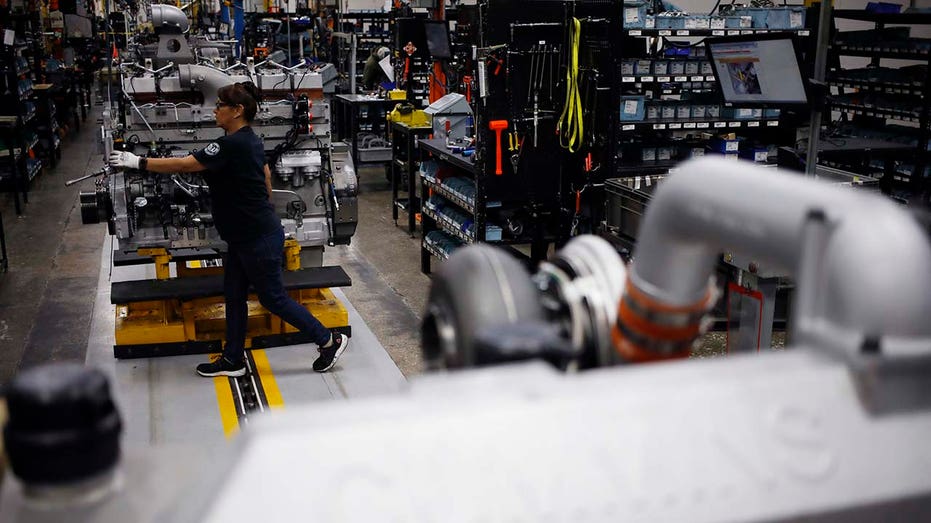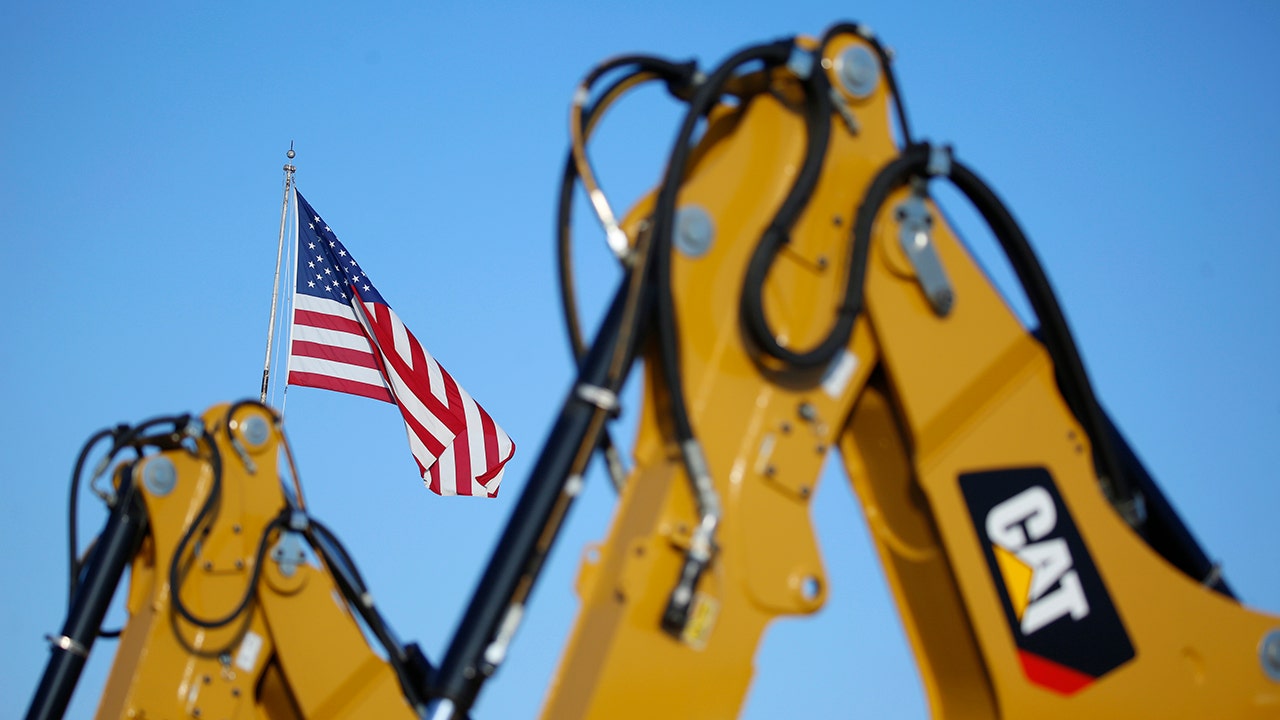South Carolina Gov. Henry McMaster and Scout Motors president and CEO Scott Keogh discuss leading the charge with a new $2 billion electric vehicle plant.
Manufacturers of construction equipment, trucks, building supplies and industrial software are still ringing up sales, despite slowdowns in other parts of the U.S. economy.
A backlog of orders stemming from supply-chain bottlenecks during the pandemic and higher demand from new factories under construction have boosted manufacturing companies, helping offset the effects of rising interest rates and weakening U.S. economic growth.
“We feel good about the market conditions,” Caterpillar Chief Executive Jim Umpleby said late last month after the construction-equipment maker’s quarterly sales rose by 17% from the same period last year and profit increased by 26%. “Our first-quarter results lead us to expect that 2023 will be even better than we previously anticipated.”
Caterpillar Inc. excavators are displayed for sale at the Whayne Supply Co. dealership in Louisville, Kentucky, on Jan. 27, 2020. (Luke Sharrett/Bloomberg via Getty Images / Getty Images)
| Ticker | Security | Last | Change | Change % |
|---|---|---|---|---|
| CAT | CATERPILLAR INC. | 214.79 | -0.30 | -0.14% |
U.S. construction spending in March rose by an adjusted rate of 0.3% from February, according to the U.S. Census Bureau. Private nonresidential-construction spending was up by an adjusted 1% from February, powered by a 4.6% increase in manufacturing-related construction, which accounts for about a quarter of nonresidential spending.
MANUFACTURERS URGE BIDEN TO REVERSE TAX CHANGES THAT HAVE HURT INVESTMENT
New factories are driving demand for construction materials, including steel, as well as the systems and equipment needed to operate the plants once they are completed. Strength in such construction projects has helped Texas-based Caterpillar and other manufacturers exceed expectations of investors and industry analysts, some of whom have worried that economic turbulence could cut into sales or diminish profit guidance.
Caterpillar’s sales of machinery and engines from North America rose 32% in the first quarter of 2023 from the same period a year earlier, offsetting slumping sales in China and smaller growth rates in other overseas markets.
For North Carolina-based steelmaker Nucor, continued robust sales of building joists, warehouse racks, overhead doors and other products made from the company’s steel helped boost profit from its steel-products business by 42% from the first quarter last year to $971 million.
| Ticker | Security | Last | Change | Change % |
|---|---|---|---|---|
| NUE | NUCOR CORP. | 141.62 | -0.70 | -0.49% |
“Semiconductor, chip plants, electric-vehicle facilities—both the assembly and battery plants—are in our order backlogs and we’re quoting even more of them,” Chad Utermark, Nucor’s executive vice president for new markets and innovation, said during a late April conference call with analysts.
Factory-software and automation-gear supplier Rockwell Automation also is benefiting from the factory-building boom. The Milwaukee-based company reported a 26% increase in quarterly sales from a year earlier, and its operating margin rose by more than 5 percentage points to 21.3% from higher sales volumes and price increases.
| Ticker | Security | Last | Change | Change % |
|---|---|---|---|---|
| ROK | ROCKWELL AUTOMATION INC. | 281.10 | -2.32 | -0.82% |
The company said demand came from new electric-vehicle and semiconductor plants, as well as from renewable-energy facilities and fossil-fuel companies seeking to reduce carbon-dioxide emissions. Rockwell CEO Blake Moret said industrial customers are investing more in automation to counter a declining force of capable factory workers in the U.S.
Rockwell raised its profit guidance in anticipation of 13% to 17% growth in core sales this year. Mr. Moret said that as supply-chain disruptions ease and the availability of components improves, Rockwell can complete orders faster and increase its sales.

Trucks line up to enter a Port of Oakland shipping terminal on Nov. 10, 2021, in Oakland, Calif. ((AP Photo/Noah Berger, File) / AP Newsroom)
Companies’ supply-chain problems left customers to endure long waits for orders, or postpone purchases or projects. Manufacturing executives said that demand didn’t vanish and is now providing momentum for sales as the availability of parts improved in recent quarters.
Production of commercial trucks has been constrained by parts shortages since the pandemic, building an order backlog the size of nearly a year’s worth of heavy-duty truck production. Paccar, which produces Kenworth and Peterbilt trucks, said it delivered 51,100 trucks during the first quarter, 19% more than during the same quarter last year.
| Ticker | Security | Last | Change | Change % |
|---|---|---|---|---|
| PCAR | PACCAR INC. | 72.78 | +0.02 | +0.03% |
The Bellevue, Wash.-based company said new truck sales rose 37% as profit from trucks more than tripled. The company expects to deliver 51,000 to 54,000 trucks in the current quarter.
“We’ve seen good order intake and we’re substantially full for the year,” said Paccar CEO Preston Feight.
FED’S RATE MOVES PUT MANUFACTURING SECTOR AT RISK
Cummins, which supplies diesel engines to Paccar and other truck makers, last week reported higher-than-expected first-quarter sales and profit because of strong demand, particularly in North America. The company projected its 2023 sales will increase by 15% to 20% over 2022, compared with 12% to 17% forecast previously.
| Ticker | Security | Last | Change | Change % |
|---|---|---|---|---|
| CMI | CUMMINS INC. | 223.74 | -2.64 | -1.17% |
Cummins said its engine sales for heavy-duty trucks rose by 23% during the quarter from last year. The Indiana-based company predicted that industrywide production of heavy-duty trucks in North America will reach 280,000 to 290,000 vehicles, an increase of 10,000 trucks on both ends of its prior range.

A worker installs components on a diesel engine at the Cummins Seymour Engine Plant in Seymour, Indiana, U.S., on Monday, April 18, 2022. (Photographer: Luke Sharrett/Bloomberg via Getty Images / Getty Images)
“Customer demand remains strong,” CEO Jennifer Rumsey told analysts.
Despite the strong outlook for trucks and engines, orders for new heavy-duty trucks last month fell 27% from April 2022 and were down 39% from March, according to a preliminary count by market forecaster ACT Research.
CLICK HERE TO GET THE FOX BUSINESS APP
With truck manufacturers’ order books for this year mostly full already and the truck industry’s order backlog still high at 218,000 trucks, analysts said they consider the 11,600 trucks ordered in April as an indication of trucking companies’ wariness about 2024, because of higher fuel prices, lower freight rates, rising interest rates and the threat of a recession.



